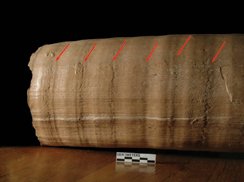Battling Mastodons
Marks on fossil tusks suggest that male mastodons were fierce warriors.
By Emily Sohn
Mastodons no longer exist, but their fossils provide glimpses of how they once lived.
Researchers now say that marks on fossil tusks suggest that male mastodons fought violent battles with each other at a certain time every year of their adult lives.
“American mastodons were not just docile herbivores that whiled away their time in forests and meadows,” says Daniel C. Fisher, a paleontologist at the University of Michigan in Ann Arbor. “They were very aggressive animals.”
 |
|
Male mastodons had curved tusks that could have been damaged in competitions for mates. |
| R. Thom/University of Michigan |
Mastodons lived in North America between 4 million and 10,000 years ago. In 1999, paleontologists in Hyde Park, N.Y., dug up long, curved mastodon tusks that dated back 11,480 years.
When Fisher looked at the undersides of the tusks, he noticed rows of shallow grooves, or pits, that were spaced at regular intervals. Then, he cut a tusk into slices and looked at them under a microscope. A closer look showed that the layer of tooth, called dentin, was damaged in the areas underneath the pits, as well.
 |
|
This mastodon tusk shows rows of pits (indicated by arrows) that reflect damage at a certain time of the year, every year. |
| Daniel C. Fisher |
Like the tusks of elephants, mastodon tusks were made of ivory, and they grew throughout an animal’s life. The cells that form new ivory lie at the base of the tusk where dentin meets the hard outer layer of the tooth, called cementum.
Based on the position of the grooves and the chemical composition of the tusks, the researchers concluded that the injuries happened between the middle of spring and summer. The damage appeared every year of the animal’s life after the age of 20.
In battle, a male mastodon would sometimes dip its head down and then swing it back up so that the tips of its tusks would stab the neck or skull of its foe. This type of blow could be fatal to the other guy, but the impact could also jam the attacker’s tusks back into their sockets. That jamming, Fisher says, could have caused the odd pattern of scars.
A mastodon fossil found in Indiana has similar markings, Fisher says, but the damage appears only after every 2 or 3 years of growth during the mastodon’s adult life. People lived alongside mastodons in the area. Fisher suspects that hunting may have reduced the number of males and the number of fights.
Fisher’s hypothesis makes sense, other scientists say, but questions still remain. Modern elephants, for example, fight with their tusks, but they don’t develop the same kind of tusk damage.
It’ll take a bit more sleuthing to truly understand the lives of the magnificent mastodons.—E. Sohn
Going Deeper:
Perkins, Sid. 2006. Mastodons in musth: Tusks may chronicle battles between males. Science News 170(Oct. 28):276-277. Available at http://www.sciencenews.org/articles/20061028/fob3.asp .
You can learn more about mastodons at www.museum.state.il.us/exhibits/larson/mammut.html (Illinois State Museum), www.sdnhm.org/exhibits/mystery/fg_mastodon.html (San Diego Natural History Museum), and en.wikipedia.org/wiki/Mastodon (Wikipedia).







